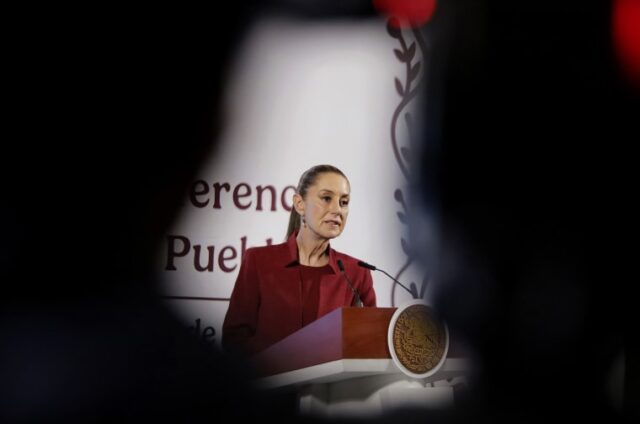The Trump administration is considering launching drone strikes on drug cartels in Mexico as part of an ambitious effort to combat criminal gangs trafficking narcotics across the southern border, according to six current and former U.S. military, law enforcement and intelligence officials with knowledge of the matter.
Discussions among White House, Defense Department and intelligence officials, which are still at an early stage, have included possible drone strikes against cartel figures and their logistical networks in Mexico with the cooperation of Mexico’s government, the sources said.
Still, the administration has made no final decision and reached no definitive agreement about countering the cartels. And unilateral covert action, without Mexico’s consent, has not been ruled out and could be an option of last resort, the sources said. It is unclear whether American officials have floated the possibility of drone strikes to the Mexican government.
If Mexico and the United States proceed together with drone strikes or other action, it would not be the first time they have launched a joint effort to take on the cartels, nor would it be the first time that American military and intelligence worked in concert with Mexico’s law enforcement and army.
But what the Trump administration is contemplating could be unprecedented both in the number of U.S. personnel involved and in the use of American unmanned aircraft to bomb cartel personnel and assets.
Administration officials and nominees have repeatedly refused to rule out drone strikes in public statements.
The U.S. military and the CIA have dramatically stepped up surveillance flights over Mexico to collect intelligence in advance of what is likely to be a major campaign against the cartels, which the White House has labeled a threat to national security, the six sources said. The flights are being carried out with Mexico’s approval, Mexican President Claudia Sheinbaum has said.
“They’re looking to build a target deck,” one of the former officials, who is familiar with the administration’s plans, said of the surveillance flights. The potential target list most likely could include cartel operatives, vehicles, warehouses and other parts of the gangs’ network, the sources said.
The White House National Security Council did not respond to a request for comment. The office of Mexico’s president and the Foreign Affairs Ministry did not respond to requests for comment.
Possible unilateral strikes
The administration has already been shifting military, intelligence and law enforcement resources toward combating the cartels, current and former officials said.
President Donald Trump’s nominee for ambassador to Mexico, Ronald Johnson, refused to rule out unilateral U.S. military action inside Mexico. Defense Secretary Pete Hegseth reportedly warned Mexican officials in private about possible unilateral U.S. action. Both have said variations of “all cards are on the table” when it comes to tackling the cartels.
According to a memoir by Mike Esper, who was defense secretary during Trump’s first term, Trump asked him in 2020 whether the military could fire missiles into Mexico to destroy drug labs and then deny the United States had conducted the strike. Trump and his aides have rejected Esper’s account as false.
The administration hopes to coordinate any action against the cartels with Mexico’s military and law enforcement agencies, the six sources said. They also said most administration officials see unilateral military action as a last resort that could cause a rupture with Mexico and jeopardize vital cooperation on immigration.
Staging a military attack on the cartels in Mexico without the government’s consent would arguably violate international law, though both Democratic and Republican administrations have argued that the United States has a right to defend itself from threats within a country that has lost control of its own security.
Advocates of using drones believe that if enough military pressure is placed on the cartels, they will decide that the cost is not worth the money they can make from fentanyl. But some experts and former U.S. officials who worked on counternarcotics are skeptical, arguing that drone strikes could prove to be merely symbolic or, worse, backfire politically for Mexican leaders and jeopardize further cooperation.
During Mexican President Felipe Calderón’s tenure from 2006 to 2012, the two countries embarked on a major campaign to strike at the cartels’ leaders, dubbed the “kingpin strategy.” American spy agencies provided intelligence, U.S. military teams trained elite Mexican commandos, and U.S. law enforcement agents worked alongside their Mexican counterparts.
Former officials and experts disagree about the results of the effort. Some former U.S. law enforcement officials maintain that it made real inroads and was cut short just as the cartels were weakening. The Bush and Obama administrations portrayed it as effective.
But targeting gang kingpins also created a vacuum and triggered a spree of intense violence among rival cartels. Once Calderón’s party was voted out of office, the joint operations with the United States ended and the government curtailed the Mexican military’s role in the counternarcotics fight.
Some supporters of the Trump administration, including the six current and former officials, argue that its refusal to publicly rule out unilateral U.S. military action, coupled with tariffs and other measures, could push Mexico to accept joint operations that it might have rejected in the past.
How far to go in targeting the cartels — including whether to use unilateral military action — is the subject of an ongoing debate in the administration, the six current and former officials said.
Mexico under pressure
Arturo Sarukhán, who was Mexico’s ambassador to the United States from 2007 to 2013, said it seems U.S. unilateral military action in Mexico is now a live possibility for the first time since 1914, when the United States attacked and occupied the port of Vera Cruz.
“There is no doubt if there were unilateral action inside Mexico, this would put the bilateral relationship into a nosedive,” said Sarukhán, who is now based in Washington. “It would be put in a tailspin, as it would represent a violation of international law and an act of war.”
Sarukhán said he believes Mexico has undermined its own position by failing to come to grips with rampant drug trafficking over the past decade, creating conditions that tried the patience of its more powerful neighbor.
“At the end of the day, it’s Mexico’s failings and mistakes that have put us in this position today,” he said.
Sheinbaum, Mexico’s relatively new president, has shown a willingness to cooperate with the Trump administration on the border and in countering the cartels, current and former U.S. officials said.
Sheinbaum had already begun to step up enforcement efforts when she took office in early October, after years of a hands-off approach under former President Andrés Manuel Lopéz Obrador, who claimed more than once that fentanyl was not produced in Mexico.
Sheinbaum’s decision to allow CIA surveillance flights during the Biden administration marked a significant change in Mexico’s stance, two current and two former officials said.
But Mexico remains sensitive to any perceived bullying or threat of domination by its larger neighbor, and Sheinbaum warned against any unilateral U.S. military action after Trump designated the cartels as foreign terrorist organizations.
“There has always been a tremendous level of suspicion by Mexican authorities of the U.S.,” said another source, a former American diplomat who served in Mexico and who spoke on condition of anonymity to discuss personal observations about discussions between the two governments. “And we haven’t exactly given them reason recently to believe any differently.”
However, one of the six sources, who was a senior Drug Enforcement Administration official in the Biden administration, said pressure from the Trump White House already has pushed Mexico to take much tougher action against drug cartels after what he called “handwringing” by the Biden team. He said he believes fear of Trump could push Mexico to accept U.S. military action.
“Politics aside, Trump is not f—— around with this stuff,” he said, adding that Mexican officials may fear potential economic retaliation if they defy the Trump administration.
‘The gloves are off’
After Trump decided to declare six Mexican drug cartels foreign terrorist organizations, U.S. intelligence agencies and military units now have sweeping legal authorities to conduct espionage and covert operations targeting the criminal networks in Mexico and beyond.
Derek Maltz, a career DEA agent now serving as its acting head, told NBC News that the designation has opened up a host of new tools and that it is something he has been advocating for many years.
Ideally, he said, the United States would secure agreement from the Mexican government before any military strikes against cartel infrastructure.
“It’s their country, and obviously we believe in strong partnerships,” Maltz said. “That said, at some point it’s about the safety of our kids.”
In Phoenix, where, the DEA says, 60% of the fentanyl that reaches the United States first arrives, DEA Special Agent in Charge Cheri Oz said that the last few months have been a breath of fresh air in the struggle to stem the flow.
“The gloves are off,” she said in an interview for “NBC Nightly News” last month. “I think what we’re doing right now is working, and I think in a few months, we’re going to start seeing, really, the rewards from our efforts.”
Maltz said there has been “historic, unprecedented action” working with Mexico on drug enforcement in the first few months of the Trump administration.

Mexico last month sent 10,000 troops to its northern border, where they are searching vehicles for fentanyl as they cross.
Also last month, Mexico extradited 29 people alleged to be drug traffickers to the United States, including Rafael “Rafa” Caro Quintero, who was convicted of masterminding the kidnapping and murder of a DEA agent in the 1980s but was released from Mexican prison in 2013. He was re-arrested in Mexico in 2022. His handover has deep meaning for DEA agents.
It is difficult to measure progress in the war on fentanyl at any moment in time. Overdose deaths fell 24% in the year that ended in September, according to the Centers for Disease Control and Prevention, but that has largely been attributed to awareness of hidden fentanyl and to Narcan treatment, and tens of thousands of people in the United States are still expected to die by fentanyl this year.
Seizure numbers fluctuate, but law enforcement officials say most of the fentanyl smuggled into the United States is not discovered, despite DEA statistics showing 125 million pills containing fentanyl seized in the Phoenix division along since 2016.
What gives officials hope right now, the current and former DEA officials said, is intelligence suggesting that Mexican cartels are off balance.
Oz, the DEA chief in Phoenix, said intelligence shows cartel leaders are unsure how to respond to the improved cooperation between the United States and Mexico and the increased pressure on their operations.
“They’re scrambling right now,” Oz said. “There’s a lot of disorganization amongst the cartels.”
Past battles and skepticism
Dating to the 1980s, American presidents have turned to law enforcement agencies, the CIA and the military to work with Mexican authorities to battle cartels. But the results have been mixed and often marked by recriminations in both countries.
Vanda Felbab-Brown, an expert on narcotics trafficking at the Brookings Institution, said building U.S. cooperation with Mexican law enforcement remains the most promising approach to get at the cartels. She said she believes interrogating key figures in the gangs’ networks would be more productive than drone strikes.
“Dropping bombs is seductive but accomplishes not very much and comes with enormous risk,” she said.
Some former diplomats and law enforcement officials are skeptical that fentanyl trafficking can be significantly curtailed through military action. They argue that there is no silver bullet and that the solution has to include close collaboration with Mexican authorities, scanning equipment at border crossings, cracking down on money laundering and enlisting the help of private companies that produce chemicals used to make the drug.

The drug is so concentrated and portable that it does not require the large-scale logistical networks associated with plant-based drugs, experts said.
“You’re talking about something that a person could put in the trunk of their car,” said Annie Pforzheimer, a former senior U.S. diplomat who worked on counternarcotics.
Mike Vigil, former chief of international operations for the DEA, said the Trump administration would be likely to struggle to find suitable targets for drone bombing raids.
The cartels do not operate large pharmaceutical labs to produce fentanyl; instead, they use “nothing more than a metal tub,” with chemicals mixed with a shovel or a long stick, Vigil said. Most of the smugglers ferrying the fentanyl across ports of entry are U.S. citizens, who easily move back and forth across the border.
“It’s not a military problem. It’s more of a law enforcement problem,” Vigil said.
But a former U.S. military officer with experience in the region believes the cartels are likely to pull back from fentanyl smuggling if they come under relentless attack and will look for a way to do business without provoking a U.S. reaction.
“Cartels are not terrorist organizations,” the former military officer said. “They are not ideologically aligned; they are not religious. They don’t want to die for their job.”





